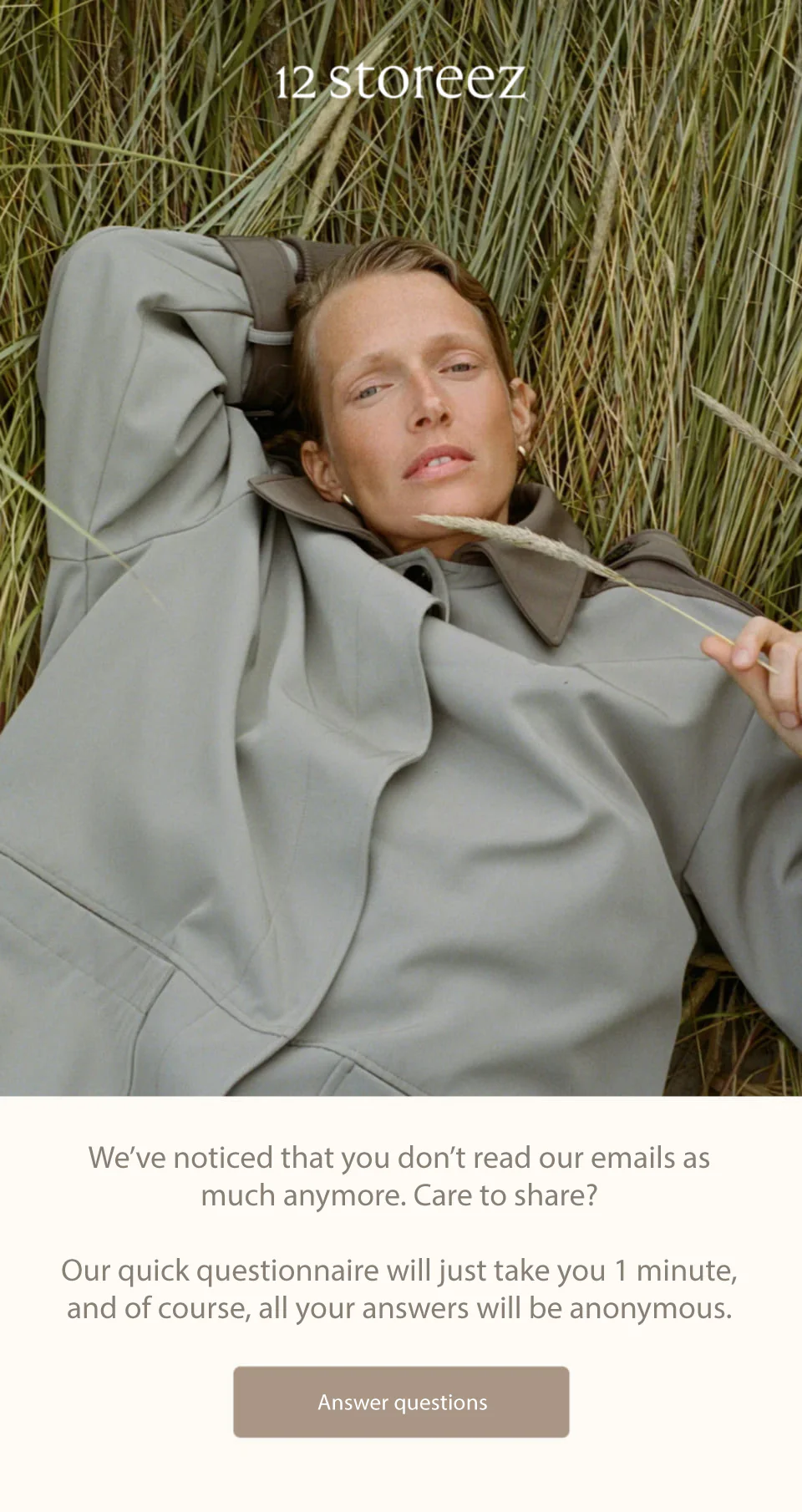Navigate email marketing with precision - calculate, reduce, and maintain constant unsubscribe rates. Benchmark for success against industry averages.
March 15, 2024
Email Unsubscribe Rate: Maintaining Consistent Engagement
Question
We’ve built a solid email list of customers interested in our product, we regularly send out updates and tips. Initially, our open rates were high, and feedback was positive. However, now I see a worrying trend: our unsubscribe rates are inching upward, and we’re not sure why.
What is normal unsubscribe rate? What are the most effective ways to reduce unsubscribes?
Answer
You can lower unsubscribe rate by treating it as an engagement and consent issue: enhance segmentation and make emails more personalized, mainain opimal frequency, improve UX, manage the subscriber lifecycle from welcome sequence to re‑engagement series, ask for feedback, keep your list clean, and avoid purchased lists.
This situation isn’t unique — it’s a common hurdle for email marketers. The challenge lies in keeping your subscribers engaged without overwhelming them or becoming irrelevant. It’s a delicate balance, trying to maintain interest and value in every email you send.
In this article, we’ll tackle the issue of email unsubscribe rate head-on — from analyzing benchmarks and exploring strategies to maintain audience interest, to identifying methods for minimizing unsubscribe rates. By the end of the article, you’ll have an understanding of how to create an email marketing strategy that keeps your unsubscribe rates low and your engagement levels high. Let’s dive in.
What is an Email Unsubscribe Rate?
The unsubscribe rate is a percentage that represents the number of people who opt out of your email list after receiving an email from you. For example, if a campaign delivers to 1,000 inboxes and 100 recipients unsubscribe, the unsubscribe rate is 10%. This figure is more than just a number — it’s an indicator of the health of your email list and the relevance of your content.
A low unsubscribe rate not only reflects well on your content’s relevance and value but also plays a significant role in maintaining high email deliverability, ensuring your emails successfully land in your subscribers' inboxes. Email service providers assess unsubscribe rates as part of their criteria to determine whether your emails are welcome or if they might be considered spam. A high unsubscribe rate can trigger spam filters, leading your emails to be redirected to the spam folder, thus reducing their effectiveness and reach.
Moreover, when subscribers choose to leave your list, it’s not just your email deliverability that’s impacted—it’s your direct line of communication to an engaged audience. High unsubscribe rates can hint at a misalignment between your messaging and your audience’s expectations or needs, potentially leading to a broader disconnect with your brand.
Why do Customers Unsubscribe from Marketing Emails?
Here are some of the most common reasons recipients may unsubscribe from emails:
Irrelevant Content
One of the primary reasons people unsubscribe is when the content they receive feels irrelevant to their interests or needs. Whether it’s promotions for products they don’t use or information that doesn’t align with their preferences, irrelevant content can quickly lead to disengagement. One way to improve this is to create defined customer segments or audiences, and deliver content that is specifically targeted to them (more on this below).
Excessive Email Frequency
Receiving too many emails can overwhelm subscribers, leading to frustration and eventual unsubscription. It’s essential to find a balance in email frequency that keeps subscribers informed and engaged without flooding their inboxes.
Poor Email Design
Emails that are difficult to read or navigate, especially on mobile devices, can deter subscribers. Poor design, including small fonts, unclear calls-to-action, or slow-loading images, can ruin the user experience, prompting recipients to unsubscribe.
Privacy Concerns
With growing awareness about data privacy, customers may unsubscribe from email lists if they are unsure why they have received the email in the first place, often stemming from unclear opt-in processes. Ensuring that subscribers have explicitly opted in and understand how their information is used is crucial in mitigating privacy concerns and maintaining trust.
How to Calculate the Email Unsubscribe Rate
Using data in your email service provider, here is how you can calculate the unsubscribe rate:
- Determine the Total Number of Emails Delivered. This is the number of emails that successfully reached the inboxes of your subscribers, excluding any emails that bounced back or were not delivered.
- Determine the Number of Unsubscribes. This is how many recipients have unsubscribed from your email list within a given period or after a specific email campaign.
- Calculate the Rate. Use the formula below to calculate your email unsubscribe rate:

Example: Suppose you sent out an email campaign to 5,000 customers, and 50 of them unsubscribed. Your email unsubscribe rate would be calculated as follows:

This means 1% of the recipients unsubscribed from your mailing list as a result of that particular campaign.
However, most email marketing tools (such as Maestra) automatically determine the email unsubscribe rate for specific campaigns or time periods, excluding the need to carry out these calculations manually.
What is a Good Unsubscribe Rate?
Determining a "good" unsubscribe rate can be somewhat subjective, as it varies across industries, audiences, and the types of content being sent. However, understanding industry averages and the factors influencing these unsubscribe rates can help you gauge the effectiveness of your email marketing campaigns and where you stack up against the competition.
Industry Benchmarks
According to research from Mailerlite, industries see unsubscribe rates ranging anywhere from as low as 0.06% (in telecommunications) to 0.51% (in architecture and construction), with the average unsubscribe rate across all industries at 0.24%. These figures serve as a rough benchmark, but it’s important to remember that the "acceptable" email unsubscribe rate can vary significantly. For instance, retail, entertainment, and publishing might experience higher rates than average due to the frequency and promotional nature of their emails, whereas B2B sectors often maintain lower unsubscribe rates due to more targeted and informational content strategies. It’s important to benchmark your unsubscribe rate against those of your industry peers and competitors to get a realistic view of your email marketing performance and understand how well you’re engaging your audience relative to others in your field.
For newly generated mailing lists, the unsubscribe rate can be higher than normal as subscribers take time to decide if they want to continue receiving your emails. Once your mailing list stabilizes, the unsubscribe rate should ideally decrease, indicating that the remaining subscribers are interested in your content.
Seven Best Ways to Reduce the Unsubscribe Rate
Whether you’re looking to reduce your current unsubscribe rate or if you want to ensure a normal unsubscribe rate in the future, here are some key strategies to help:
Enhance Personalization and Segmentation
Integrating advanced personalization with audience segmentation can dramatically transform the effectiveness of your email campaigns. Start by analyzing your subscriber data to create detailed segments based on demographics, engagement levels, purchase history, and even behavior patterns. Use this information to tailor your emails, ensuring that the content speaks directly to the interests, needs, and preferences of each segment.
Utilize machine learning or AI-driven tools to automate the personalization process, enabling dynamic content that adapts to subscriber actions. For instance, if a subscriber frequently opens emails about new tech gadgets, your system should prioritize similar content for future communications to them. Additionally, regularly update your segments to reflect changes in subscriber behavior and preferences, ensuring your personalization efforts remain effective. A good example here is Maestra’s client, Beethoven. The pet store retailer uses machine learning algorithms to pinpoint the best sending time for an email campaign for customers that may potentially be running out of products they previously purchased:
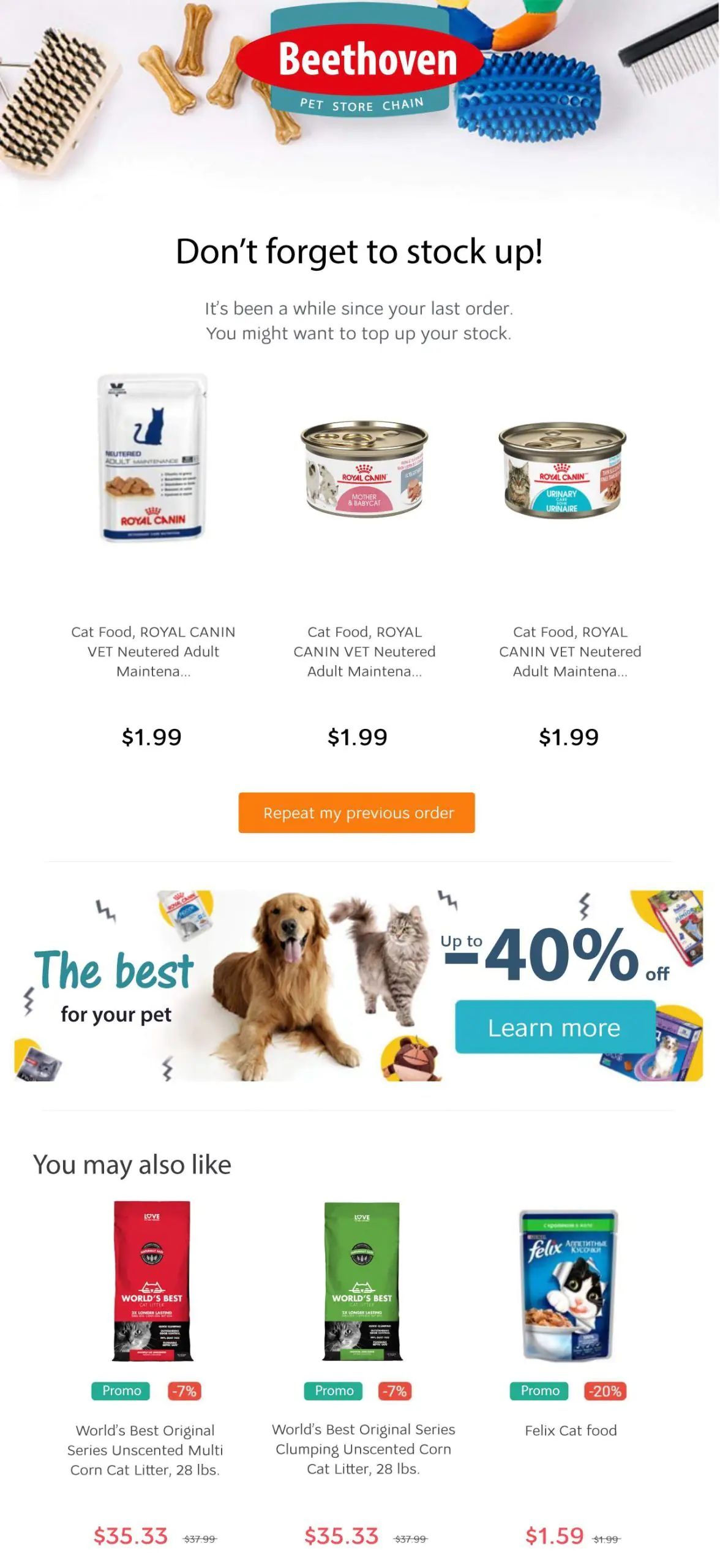
The email lists products that the customer purchased and contains a convenient “Repeat my purchase” button to streamline the ordering process
Algorithms like these not only help brands avoid spamming customers with offers they may not be interested in but also add a personalized, caring touch by reminding customers to replenish their supplies before they run out, leaving them with a positive impression.
Optimize Email Frequency
Maintaining optimal email frequency is key to keeping subscribers engaged without overwhelming them.
Conduct A/B testing to find the best days and times to send emails, as well as to determine the most effective frequency for different segments of your audience. Consider implementing a preference center where subscribers can customize their email frequency and content types, giving them control over what they receive.
Another way to optimize the frequency is using machine learning algorithms. Here is an example from one of Maestra’s clients that can be used as a rough template:
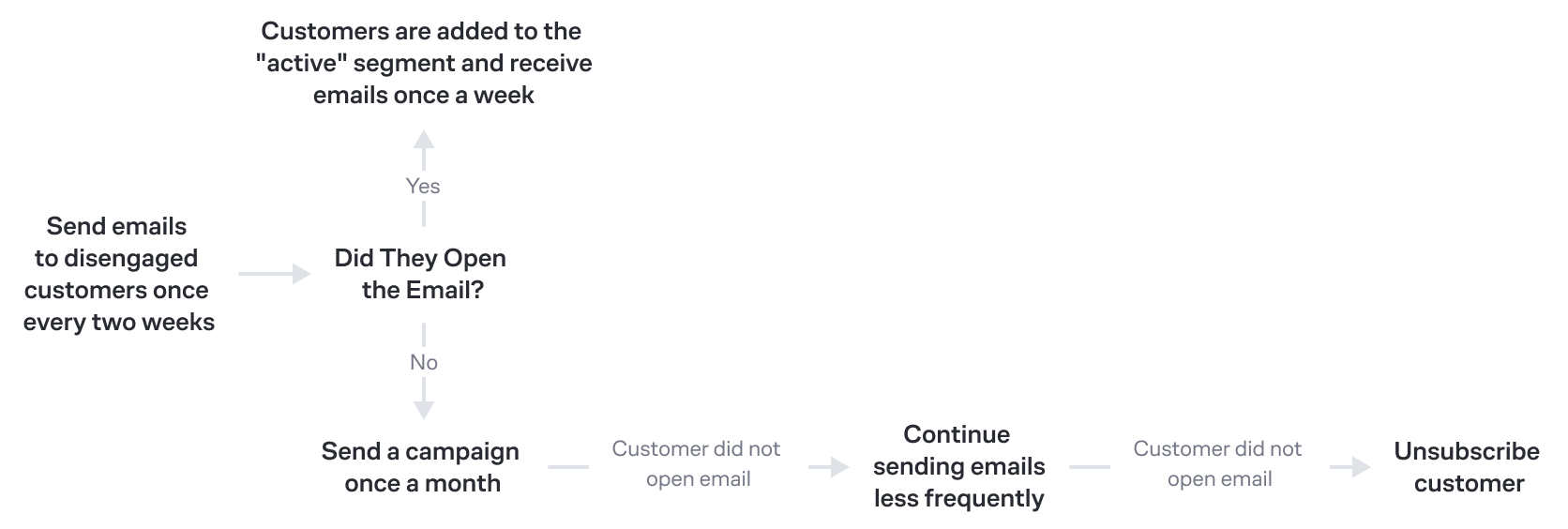
This strategy reduces the communication frequency for unresponsive customers
The algorithm monitors campaign engagement — those that have become less responsive receive less frequent campaigns, reducing the risk of unsubscribes or spam complaints from disengaged subscribers. If recipients continue to ignore emails, they are eventually unsubscribed from the mailing list — this approach is also known as “sunsetting”. Implementing a sunsetting strategy ensures that your email list remains high-quality and engaged by removing subscribers who consistently show no interest in your content.
Improve User Experience and Engagement
Ensuring emails are mobile-responsive, easy to navigate, and feature clear calls-to-action (CTAs) can significantly enhance engagement and reduce the likelihood of unsubscribes.
Given the high volume of users accessing emails via mobile devices, it can be a good idea to design emails with a mobile-first approach — or, at the very least, put just as much effort into ensuring the mobile version works as well as the desktop variant. Test your campaign before sending to ensure the email loads quickly, displays properly on various screen sizes, and links and buttons are easily clickable and work. Tools with inbuilt email marketing functionality (such as Maestra) will have this feature built in to the interface, allowing you to preview and test your campaigns with ease.
Manage Subscriber Lifecycle
Understanding and managing the subscriber lifecycle — from the welcome series to re-engagement campaigns — can also be important for minimizing unsubscribes. Tailoring content to match each stage of the lifecycle ensures subscribers receive relevant and engaging communications that evolve with their relationship with your brand.
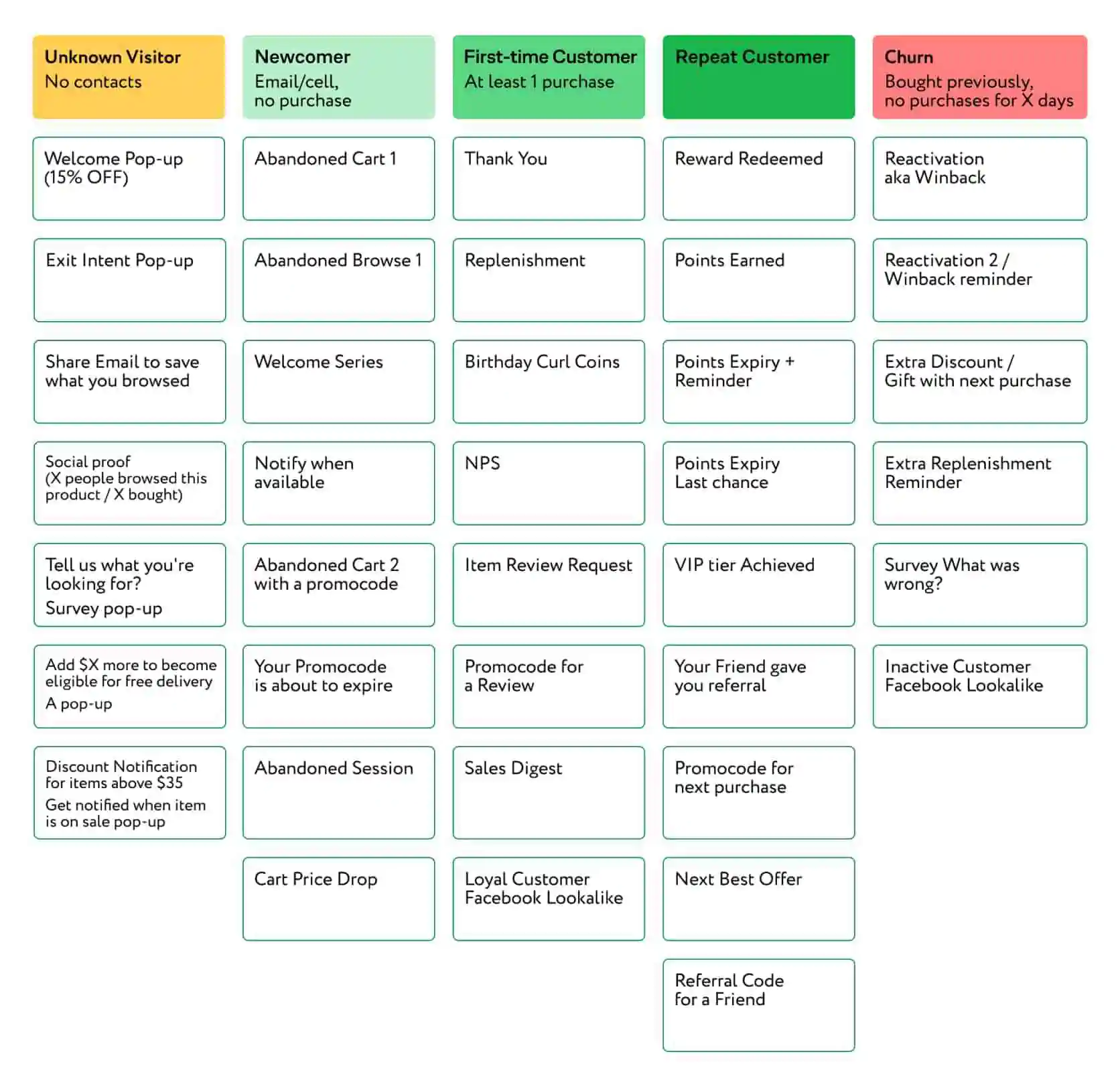
A tailored campaign plan revolving around the customer lifecycle from PuffCuff
Develop a structured email sequence for subscribers at the beginning of the customer lifecycle, gradually introducing them to your brand, setting expectations, and highlighting the value of staying subscribed. Here is a great example from online farm food delivery store, Pinemelon:


Each email emphasizes Pinemelon’s advantages and includes personalized product recommendations to help customers select products they’ll love
Finally, monitor engagement metrics to identify inactive subscribers and implement targeted re-engagement campaigns offering special incentives, personalized content, or a simple reminder of the benefits of your emails.
Ask for Feedback
Soliciting feedback from your subscribers can provide invaluable insights into their preferences, pain points, and the overall user experience. By directly asking for their input, you not only show that you value their opinion but also gain specific guidance on how to adjust your email campaigns to better meet their needs.
Start by incorporating a simple feedback form or survey in your emails and on the unsubscribe confirmation page, making it easy for subscribers to share their thoughts. This allows you to gather insights from individuals who are considering unsubscribing, as well as maintain an open channel of communication with your active audience. Regularly analyzing this feedback helps identify patterns or specific issues, providing a clear direction for making meaningful adjustments to your email content, frequency, and design.
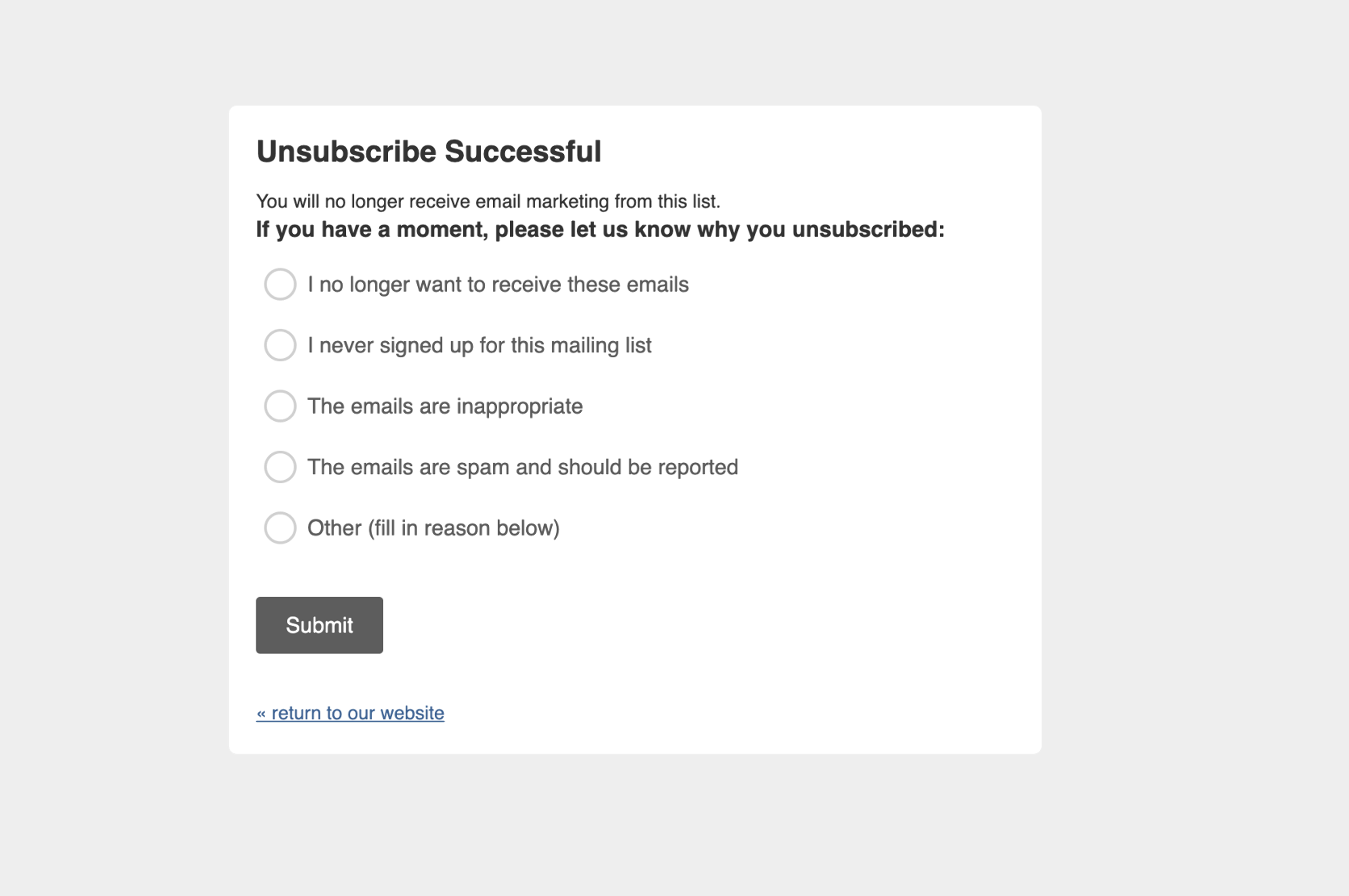
An example of a short post-unsubscription survey
Upon reviewing subscriber feedback, it’s important to act on the insights you’ve gathered. Whether it’s tweaking your email strategy to better align with subscriber preferences or enhancing the overall user experience based on their suggestions, making these changes can significantly improve subscriber satisfaction and loyalty. Additionally, informing your subscribers about the adjustments you’ve made in response to their feedback reinforces the value you place on their input and can strengthen their connection to your brand.
Clean Your List
Regularly cleaning your email list, also known as list hygiene, is a critical practice for maintaining a high-quality subscriber base. This process involves removing inactive or unengaged subscribers, incorrect email addresses, and those who have opted out. By focusing on an audience that actively engages with your content, you can improve overall campaign performance, email deliverability, and subscriber satisfaction.
Identify inactive subscribers by setting criteria for engagement, such as no opens or clicks within a specific timeframe, typically six months to a year. Use this data to segment these subscribers and send a targeted re-engagement campaign. This campaign can ask if they’re still interested in receiving your emails or offer an incentive to re-engage.
For those who do not respond to the re-engagement campaign, consider removing them from your list (as exemplified in the email frequency section above). Similarly, routinely check for and eliminate invalid email addresses that result in hard bounces. Email validation tools can automate this process, ensuring your list remains clean and deliverability rates stay high.
Avoid Purchasing Email Lists
Acquiring email lists through purchase can seem like a quick way to expand your audience, but this practice comes with significant risks that can harm your brand and email marketing efforts, namely:
- An increased risk of being blacklisted by Internet Service Providers (ISPs).
- Legal repercussions under laws like the GDPR and CAN-SPAM Act, which require explicit consent for email communications.
- High bounce rates and low engagement due to the fact that purchased lists often contain outdated, incorrect, or unconsented contacts.
Place emphasis on collecting first party data and building your email list organically through your website, social media channels, and other customer touchpoints. Consider the following tactics to enrich your list-building strategy:
- Utilize Content Marketing: Create valuable, shareable content on your blog or website that includes calls-to-action (CTAs) encouraging email subscriptions. High-quality content not only attracts traffic but can convert visitors into subscribers.
- Leverage Social Media Platforms: Conduct targeted campaigns on social media that promote your email list as a source for exclusive updates or benefits. Use engaging visuals and direct CTAs to encourage sign-ups directly from your social media profiles or through linked landing pages.
- Host Webinars and Online Events: These provide an excellent opportunity to gather email addresses as part of the registration process. Offer insightful, valuable webinars on topics relevant to your target audience to encourage sign-ups.
- Implement Exit-Intent Pop-Ups: When strategically placed on your website, these pop-ups wan capture the attention of visitors intending to leave your site without subscribing or making a purchase. Offer a compelling reason within the pop-up for them to subscribe to your email list — for example, offer visitors a discount or to send them products they browsed during their session.
Final Thoughts
By effectively managing your unsubscribe rate, you can cultivate a more engaged and interested set of subscribers, leading to more successful email marketing campaigns. However, the goal ultimately transcends merely reducing unsubscribe rates — it’s about cultivating a meaningful dialogue with subscribers. Through continuous improvement, determining and respecting subscriber preferences, as well as leveraging the latest technologies, marketers can forge deeper customer relationships.
It’s also important to understand email engagement in the context of the broader customer journey. Email marketing should be integrated into an omnichannel engagement strategy that spans multiple touchpoints, enriching the overall customer experience. This enables marketers to create a more cohesive and impactful communication ecosystem, which in turn maintains consistent engagement and makes your campaigns something that customers truly look forward to, with far fewer seeking to unsubscribe.



